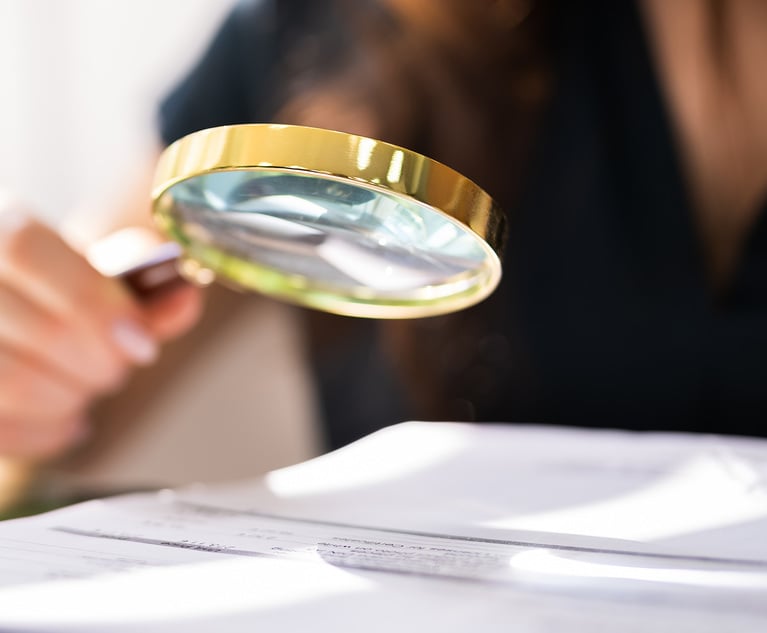 Credit: whyframeshot / Adobe Stock
Credit: whyframeshot / Adobe Stock Cramdown Litigation: Considering COVID in Valuing Real Estate in Chapter 11 Cases
Valuation of real estate in Chapter 11 cases is challenging to begin with, and adding the effect of COVID-19 to the equation will make litigating valuation issues much more complicated. This article discusses a few cases that provide some guidance on what courts are looking at.
January 26, 2022 at 10:00 AM
10 minute read
Valuation of real estate in Chapter 11 cases is challenging to begin with, and adding the effect of COVID-19 to the equation will make litigating valuation issues much more complicated. Although it is clear COVID-19 has affected most facets of our economy, quantifying the impact on real estate will lead to increased valuation hearings and motions in limine challenging the data relied upon by appraisers and their ultimate opinions of value. Also, COVID-19 did not have the same effect on all assets classes, with industrial properties doing much better as the demand for warehouse space increased, while lodging took a substantial hit with soaring hotel vacancy rates. It is likely that the lifting of various COVID-19 moratoriums and the expiration of forbearance agreements will cause a spike in Chapter 11 filings, leading to epic cramdown battles between debtors and secured creditors.
Generally, real estate is valued at its highest and best use with appraisers conducting a four-part test to determine a use that is legally permissible, physically possible, financially feasible, and maximally productive. However, under the Bankruptcy Code, when a debtor intends to retain property and pay the secured creditor over time, the property is valued based upon the debtor's intended use of the property, which is not always the highest and best use of the property. 11 U.S.C. §506(a). In addition, the property is to be valued using the "replacement value" standard, which is the price a willing buyer in the debtor's trade, business, or situation would pay a willing seller to obtain property of like age and condition. With these fundamental concepts in mind, we can turn to valuing real estate in the era of COVID-19.
This content has been archived. It is available through our partners, LexisNexis® and Bloomberg Law.
To view this content, please continue to their sites.
Not a Lexis Subscriber?
Subscribe Now
Not a Bloomberg Law Subscriber?
Subscribe Now
NOT FOR REPRINT
© 2025 ALM Global, LLC, All Rights Reserved. Request academic re-use from www.copyright.com. All other uses, submit a request to [email protected]. For more information visit Asset & Logo Licensing.
You Might Like
View All
Bankruptcy Judge Clears Path for Recovery in High-Profile Crypto Failure
3 minute read
Topping Kirkland, Weil Won the Most Valuable Major Bankruptcy Retentions of 2024

How New Jersey’s Pragmatic Bankruptcy Approach Sets It Apart Post-'Purdue Pharma'
7 minute readLaw Firms Mentioned
Trending Stories
- 1Poop-Themed Dog Toy OK as Parody, but Still Tarnished Jack Daniel’s Brand, Court Says
- 2Meet the New President of NY's Association of Trial Court Jurists
- 3Lawyers' Phones Are Ringing: What Should Employers Do If ICE Raids Their Business?
- 4Freshfields Hires Ex-SEC Corporate Finance Director in Silicon Valley
- 5Meet the SEC's New Interim General Counsel
Who Got The Work
J. Brugh Lower of Gibbons has entered an appearance for industrial equipment supplier Devco Corporation in a pending trademark infringement lawsuit. The suit, accusing the defendant of selling knock-off Graco products, was filed Dec. 18 in New Jersey District Court by Rivkin Radler on behalf of Graco Inc. and Graco Minnesota. The case, assigned to U.S. District Judge Zahid N. Quraishi, is 3:24-cv-11294, Graco Inc. et al v. Devco Corporation.
Who Got The Work
Rebecca Maller-Stein and Kent A. Yalowitz of Arnold & Porter Kaye Scholer have entered their appearances for Hanaco Venture Capital and its executives, Lior Prosor and David Frankel, in a pending securities lawsuit. The action, filed on Dec. 24 in New York Southern District Court by Zell, Aron & Co. on behalf of Goldeneye Advisors, accuses the defendants of negligently and fraudulently managing the plaintiff's $1 million investment. The case, assigned to U.S. District Judge Vernon S. Broderick, is 1:24-cv-09918, Goldeneye Advisors, LLC v. Hanaco Venture Capital, Ltd. et al.
Who Got The Work
Attorneys from A&O Shearman has stepped in as defense counsel for Toronto-Dominion Bank and other defendants in a pending securities class action. The suit, filed Dec. 11 in New York Southern District Court by Bleichmar Fonti & Auld, accuses the defendants of concealing the bank's 'pervasive' deficiencies in regards to its compliance with the Bank Secrecy Act and the quality of its anti-money laundering controls. The case, assigned to U.S. District Judge Arun Subramanian, is 1:24-cv-09445, Gonzalez v. The Toronto-Dominion Bank et al.
Who Got The Work
Crown Castle International, a Pennsylvania company providing shared communications infrastructure, has turned to Luke D. Wolf of Gordon Rees Scully Mansukhani to fend off a pending breach-of-contract lawsuit. The court action, filed Nov. 25 in Michigan Eastern District Court by Hooper Hathaway PC on behalf of The Town Residences LLC, accuses Crown Castle of failing to transfer approximately $30,000 in utility payments from T-Mobile in breach of a roof-top lease and assignment agreement. The case, assigned to U.S. District Judge Susan K. Declercq, is 2:24-cv-13131, The Town Residences LLC v. T-Mobile US, Inc. et al.
Who Got The Work
Wilfred P. Coronato and Daniel M. Schwartz of McCarter & English have stepped in as defense counsel to Electrolux Home Products Inc. in a pending product liability lawsuit. The court action, filed Nov. 26 in New York Eastern District Court by Poulos Lopiccolo PC and Nagel Rice LLP on behalf of David Stern, alleges that the defendant's refrigerators’ drawers and shelving repeatedly break and fall apart within months after purchase. The case, assigned to U.S. District Judge Joan M. Azrack, is 2:24-cv-08204, Stern v. Electrolux Home Products, Inc.
Featured Firms
Law Offices of Gary Martin Hays & Associates, P.C.
(470) 294-1674
Law Offices of Mark E. Salomone
(857) 444-6468
Smith & Hassler
(713) 739-1250







